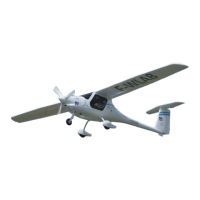7-26
PAGE
ALPHA Trainer LSA
Pilot Operating Handbook
POH-162-00-40-001
PAGE REV. 0
SECTION 7
AIRPLANE DESCRIPTION
Before Flight” streamer is attached to the pin.
WARNING: Always remove the safety pin of the BPRS before engine
start-up and re-insert before leaving the aircraft.
WARNING: After maintenance has been performed or any other time
the system has been safe tied, operators must verify that the pin has been
removed before further flight.
7.15.3 DEPLOYMENT CHARACTERISTICS
When the rocket launches, the parachute assembly is extracted outward due
to rocket thrust and rearward due to relative airflow. In approximately two
seconds the parachute will begin to inflate.
When air begins to fill the canopy, forward motion of the airplane will dramat-
ically be slowed. This deceleration increases with airspeed but in all cases
within the parachute envelope should be less than 4 g’s. During this de-
celeration a slight nose-up may be experienced, particularly at high speed.
Following any nose-up pitching, the nose will gradually drop until the aircraft
is hanging nose-low beneath the canopy. Descent rate is expected to be
less than 1500 feet per minute with a lateral speed equal to the velocity of
the surface wind. In addition, surface winds may continue to drag the aircraft
after ground impact.
CAUTION: Ground impact is expected to be equivalent to touchdown from
a height of approximately 3 meters. Occupants must prepare for it in ac-
cordance with the BPRS Deployment procedure in Section 3 - Emergency
Procedures.
NOTE: The BPRS is designed to work in a variety of aircraft attitudes, includ-
ing spins. However, deployment in an attitude other than level flight may
yield deployment characteristics other than those described above.

